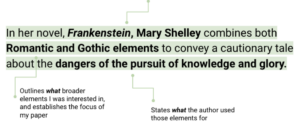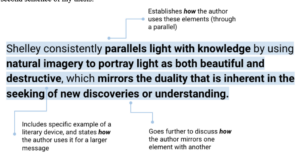One Writing Center Consultant’s Process for Writing a Literary Analysis Thesis Statement
Cailey Rogers is a class of 2024 Writing Center consultant. She is studying Journalism and English Literature. At Elon, she is a Communications Fellow and is involved in Elon Learning Assistance, Colonnades Literary and Art Journal, and the Pendulum.
In my short time at Elon, I have found that the most challenging and rewarding part of writing a long literary analysis paper is the thesis statement. It’s funny how just one small portion of what can become an eight-page essay seems impossible to accomplish. If you feel that way, you are certainly not alone. Even English majors struggle with it – I can say that from personal experience! That is exactly why I decided to share the tips and processes that have helped me the most when writing a literary analysis thesis statement in hopes that it could help others staring at a blank document, not knowing where to start or feeling like they will never be able to write a good paper about a piece of literature. If you want to know some of the general tips and tricks that I have acquired through my English classes and some other resources, you can read my first blog post here.
The What, The How, and The Why of a Thesis Statement
For my personal process, I approach writing a thesis statement like writing a puzzle with three different pieces that fit perfectly together. I call these pieces the “what,” the “how,” and the “why.” Sometimes, this means that my thesis statement consists of three different sentences, each fulfilling one purpose; sometimes I can check off two or more of the pieces in just one sentence. But don’t feel the need to limit yourself to one single sentence when you’re writing a thesis statement. I’m here to tell you that the “one sentence thesis statement” rule that was enforced in middle school and high school was made to be broken. Literature is inherently complex, so it is natural for your literary analysis essays to be equally intricate. Take an extra sentence or two; it certainly couldn’t hurt. I try not to go beyond three, though, because then you are writing an introductory paragraph. Just make sure to check off these three components first and worry about streamlining later.
To illustrate this process, I will now break down each of the three pieces and use a thesis statement I used for my literary analysis on Frankenstein by Mary Shelley as an example.
The What:
The first part of my thesis will state something about the text that I know I want to focus on, or that contributes to my argument. This can be a significant pattern, something important about the time period the text was written in, or a larger theme that I want to delve into. This sentence is also where I would include basic information about the title of the text and its author. For example, my first sentence of my Frankenstein thesis statement reads:
The first thing the sentence does is establish the text and author, but what follows is a very straightforward statement that establishes both the types of elements the essay will focus on (Romantic and Gothic), and what the author used them for (to tell a cautionary tale about the dangers of pursuing knowledge). So really, the purpose of this one sentence is to tell the audience the broader topics that will be discussed before delving into the specifics of the analysis. It doesn’t just introduce what aspects of the text I will be focusing on, but also what the author did with them. Think of this part as a preview to the rest of your thesis and the paper as a whole. Use this as an opportunity to show what part of the text really interests you, and in the next two parts you can go into what you have to say about it.
The How:
The second piece of the puzzle usually consists of explaining what literary strategies the authors used in order to develop a theme, highlight certain elements, create a pattern, etc. This is where you can start to identify some more specific ideas or elements that you will discuss throughout your paper, while also showing how those facets added to a more universal message (remember the idea of addressing the wider implications of the text from my first blog post). Here is the second sentence of my thesis:
While in the previous sentence I say what Mary Shelley used Romantic and Gothic elements for, in this statement I not only say which specific elements those are, but also how she uses them to convey a larger message. Instead of letting the statement remain broad, I explicitly outline that I will be analyzing light imagery. Then, I go further to discuss how Shelley used light imagery as parallel to knowledge, and therefore highlighted a sense of duality in both elements. This starts building a clear roadmap for your audience, as it now becomes evident that my essay will provide examples of light being mirrored with knowledge and highlight the dual natures in each of them. You want your thesis to be able to stand alone, so this sentence becomes crucial to introducing specific details of your paper, but also giving your reader an understanding of how you will be engaging in an analysis with those elements.
The Why:
To me, the final piece is the most important, because it should encompass the main argument that you will be defending in your analysis. It should not just state why the author made certain decisions to portray a message – as in, what point was the author trying to make when including certain themes, patterns, or literary elements – but it should also make it clear why you are writing about it. This should be the crux of your analysis, and it should also be the part that is really debatable about the thesis. Make sure to include your own ideas: What are you arguing about this text and the literary choices embedded within it? What does this analysis say about the overarching aim of the text itself? This was mine:
Finally, I state the key piece of the argument and analysis that drives the whole paper. I make sure to include the specific literary elements that I summarized in the previous sentence (the duality of light and knowledge), but I now explain why I think Shelley included them and what universal message she wanted to convey through that aspect of her novel. By laying out the author’s reasons behind certain literary choices, I simultaneously elucidate the purpose behind my analysis as well. It becomes evident that I want to prove that one of Shelley’s aims in writing Frankenstein was to illuminate the danger of knowledge – this wraps up the thesis perfectly because it finally makes it truly arguable. Anybody could have pointed out that Shelley included light imagery in her novel, or even that she highlighted the duality of knowledge throughout the text. But this sentence makes my thesis more individualized because I now argue why she does that.
If you can get this part of the thesis right, you are more than halfway there. To test if this vital part is working, try isolating it from the other two pieces – if it works on its own and makes your argument comprehensible to your audience, then you’re certainly on the right track.
The full thesis statement ends up like this:
If you ever find yourself struggling with a literary analysis thesis statement, please come and run it by one of the writing consultants at The Writing Center! We’d be happy to help you in anything you need, but if you are writing a literary analysis essay, you can always find me. As I said, they are my favorite things to write, and I would love to help you with yours!






Leave a Reply
You must be logged in to post a comment.